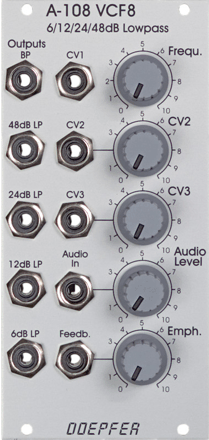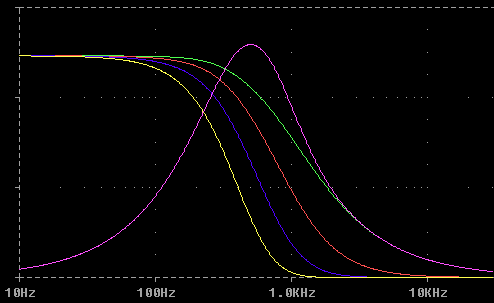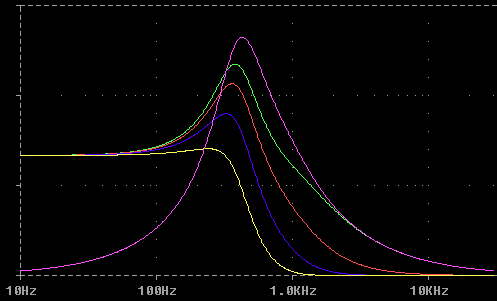|
A-108 6/12/24/48dB Low Pass Filter |
|||
|
Das Modul A-108 ist ein völlig neuartiges spannungsgesteuertes Tiefpass/Bandpass-Filter, das auf der bekannten Transistor-Kaskadenschaltung (Moog-Kaskade) basiert. Es verfügt intern über ein 8-stufiges Tiefpass-Filter mit 6, 12, 18, 24, 30, 36, 42 und 48 dB Flankensteilheit. Von den 8 intern verfügbaren Stufen, sind jedoch nur die Ausgänge mit 6, 12, 24 und 48dB auf Ausgänge geführt. Diese erscheinen uns nach den ersten Hör-Ergebnissen am sinnvollsten, da hier die Unterschiede deutlich hörbar sind. So ist beispielsweise der Unterschied zwischen 24dB und 32dB oder zwischen 42 und 48 dB kaum hörbar. Falls jedoch eine der anderen Stufen als Ausgang zur Verfügung stehen soll, so kann dies intern geändert werden. Anmerkung: Es sind 4 Ausgangsstufen vorhanden, die ab Werk auf die Filterstufen mit 6, 12, 24 und 48 dB gelegt sind. Durch Ändern der internen Verschaltung (Jumper) kann bei Bedarf jede der 8 Stufen auf einen Ausgang gelegt werden, jedoch immer nur 4 gleichzeitig. Im Prinzip könnte auch ein Mehrfach-Umschalter verwendet werden. Aus unserer Sicht stellt die Einstellung ab Werk (6/12/24/48dB) jedoch die beste Kombination dar. Nähere Hinweise hierzu weiter unten (nach der Darstellung der Frequenzgänge). Die Resonanz (Emphasis) des A-108 kann bis hin zur Eigenschwingung eingestellt werden. Der A-108 arbeitet dann als Sinus-Oszillator. Es steht ein externer Eingang (feedb.) für die Resonanz zur Verfügung, der intern auf den 48dB-Ausgang geführt ist, wenn kein Kabel in die Feedback-Buchse eingesteckt wird. In den Rückkopplungsweg können somit beliebige andere Module eingeschleift werden (z.B. VCA für spannungsgesteuerte Resonanz oder Phaser/ Frequenzschieber für Phasen/Frequenzschieber-Effekte). Die Frequenz ist manuell (Frequ.-Regler) und über 3 Steuerspannungen (CV1, CV2, CV3) steuerbar, wobei für CV2 und CV3 je ein eigener Abschwächer zur Verfügung steht. Der Audio-Eingang ist so empfindlich, dass bereits bei normalen A-100-Pegeln (z.B. VCO-Ausgang) Übersteuerungen möglich sind. Bei starker Übersteuerung und gleichzeitiger Eigenschwingung (Sinus-Oszillator) reisst die Eigenschwingung ab. Dies kann u.U. als zusätzliches Stilmittel eingesetzt werden. In Verbindung mit dem spannungsgesteuerten Mixer A-135 und dem Morphing-Controller A-144 kann ein Filter mit spannungsgesteuerter Flankensteilheit 6...48dB realisiert werden. In den untenstehenden Graphiken ist der Frequenzgang der 5 verschiedenen Filterausgänge bei 3 verschiedenen Resonanz-Einstellungen graphisch dargestellt. Die deutsche Bedienungsanleitung zum A-108 ist als PDF-Datei A108_Anl.pdf auf unserer Website verfügbar.
|
||
|
|
|||
|
Module A-108 is a completely new voltage-controlled low pass pass filter based on the well-known transistor ladder (Moog ladder). The module has internally an 8 stage low pass filter with different slopes available: 6, 12, 18, 24, 30, 36, 42 and 48 dB per octave. In addition it features an band pass output (i.e. band pass with transistor ladder). In the factory the 4 low pass outputs of the A-108 are internally connected to the filter stages 6, 12, 24 and 48dB. From our first A-108 audio tests this seems to be the best output combination as these outputs generate audible different sounds. E.g. the audible difference between the 48dB and 42dB or between 42dB and 36dB is very little. But if desired any of the filter stages can be connected to one of the outputs. Remark: Only 4 output stages are available as this seems to be sufficient from our experiences. In the factory the out stages are connected to the filter stages with 6, 12, 24 and 48 dB slope. By changing the internal connections (jumpers or wires) each of the filter stages can be used but only four at a time. Even a multi-way switch could be used but from our results the factory setting (6/12/24/48dB) is the best combination for musical applications. More details below (after the frequency response pictures). Resonance (Emphasis or Q ) can be adjusted manually right up to self-oscillation, in which case the filter will behave like a sine wave oscillator. The A-108 features an external feedback input that enables the insertion of additinal modules into the feedback path (e.g. VCA for voltage controlled resonance or phaser/frequency shifter for phase/frequency shifting effects). The socket is normalized and internally connected to the 48dB low pass output if no cable is inserted into the feedback socket. The frequency can be adjusted manually, or by voltage control. Three CV inputs (CV1, CV2, CV3) are available. CV2 and CV3 are equipped with attenuators. The filter audio input is very sensitive so that distortion - if desired - is possible even with normal A-100 levels (e.g. VCO output). Self oscillation will break off at high distortion levels as the internal feedback signal is drown out by the distorted audio signal. This feature may intentionally be used to create new sounds. In combination with the Voltage Controlled Mixer A-135 and the Morphing Controller A-144 a filter with voltage controlled slope can be realized (i.e. controlling the slope from 6dB to 48dB via CV). The sketches below show the frequency response of the five filter outputs at three different resonance settings. The English user's manual is available on our web site as pdf file: A108_man.pdf.
|
||
|
|
|||
|
Klangbeispiel
unseres Kunden Andreas Krebs / sound example by our customer Andreas
Krebs: http://blog.andreaskrebs.de/2010/04/29/doepfer-a-108-6122448-db-lowpass-example/ |
|||
|
|
|||
| Breite/Width: 12
TE / 12 HP / 60.6 mm Tiefe/Depth: 75 mm (gemessen ab der Rückseite der Frontplatte / measured from the rear side of the front panel) Strombedarf/Current: +40mA (+12V) / -40mA (-12V) |
|||
|
|
|||
| Preis/Price: Euro
180.00 The price in US$ depends upon the exchange rate between Euro and US$ at the payment day. |
|||


